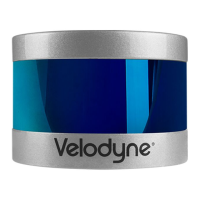Chapter 9 • Sensor Data
This chapter provides detailed information about sensor data characteristics.
9.1 Sensor Origin and Frame of Reference
52
9.2 Calculating X,Y,Z Coordinates from Collected Spherical Data
52
9.3 Packet Types and Definitions
54
9.3.1 Definitions
54
9.3.2 Data Packet Structure
56
9.3.3 Position Packet Structure
60
9.4 Discreet Point Timing Calculation
61
9.5 Precision Azimuth Calculation
65
9.6 Converting PCAP Files to Point Cloud Formats
66
9.1 Sensor Origin and Frame of Reference
The sensor reports distances relative to itself in spherical coordinates (radius r, elevation ω, azimuth α). Sensor data origin
(0,0,0) is 37.7 mm above the sensor base, on the center axis, as shown in
Figure 9-1 on the facing page
(see the side and
top views), which also shows the sensor’s frame of reference. See also the mechanical/optical drawings in
VLP-16 and
Puck LITE Mechanical Drawing on page 102
.
9.2 Calculating X,Y,Z Coordinates from Collected Spherical Data
A computation is necessary to convert the spherical data (radius r, elevation ω, azimuth α) from the sensor to Cartesian
coordinates.
Figure 9-1 on the facing page
lists the formulas for converting spherical coordinates (R, ω, α) to Cartesian
coordinates (X, Y, Z).
52 VLP-16 User Manual

